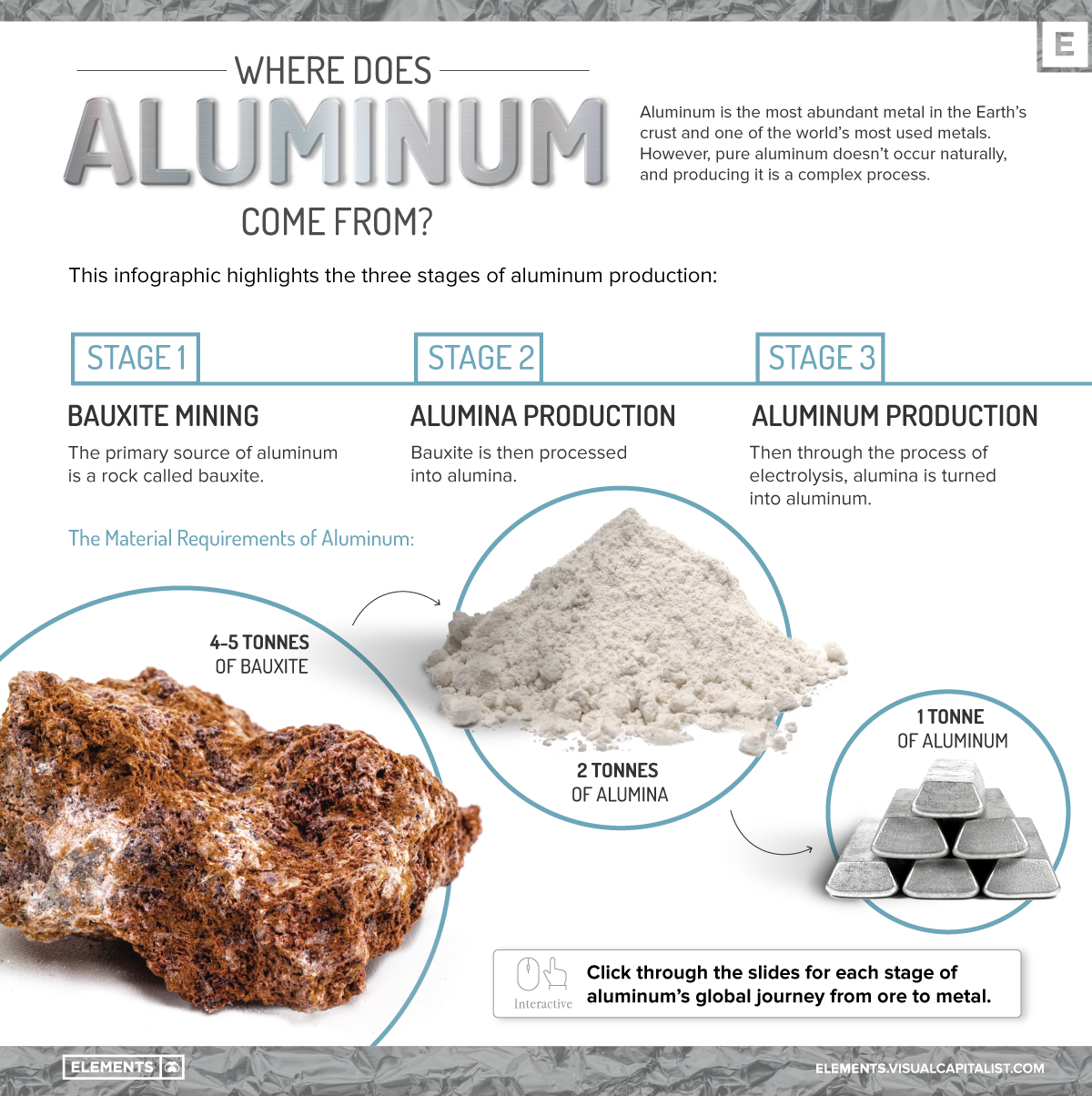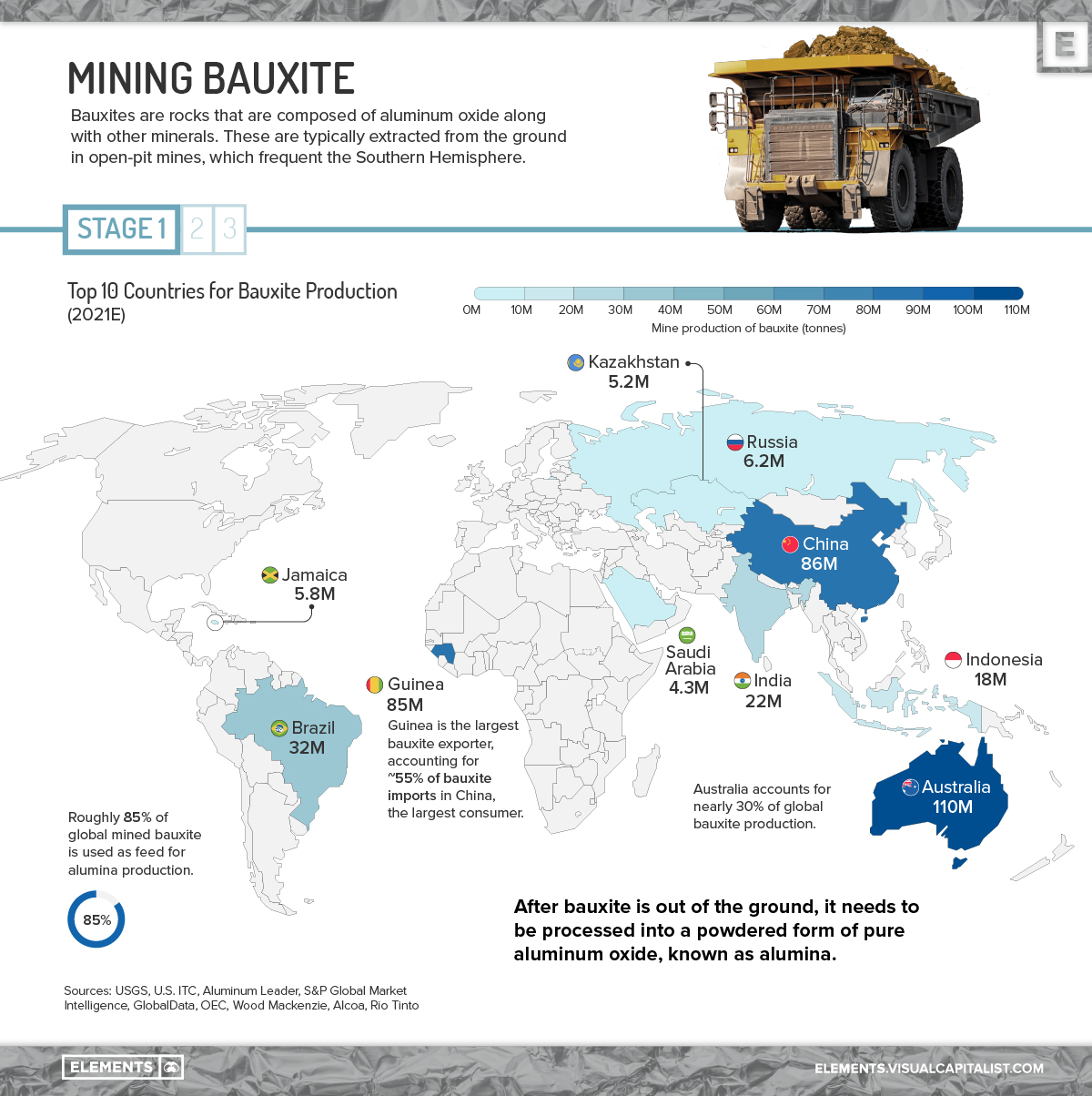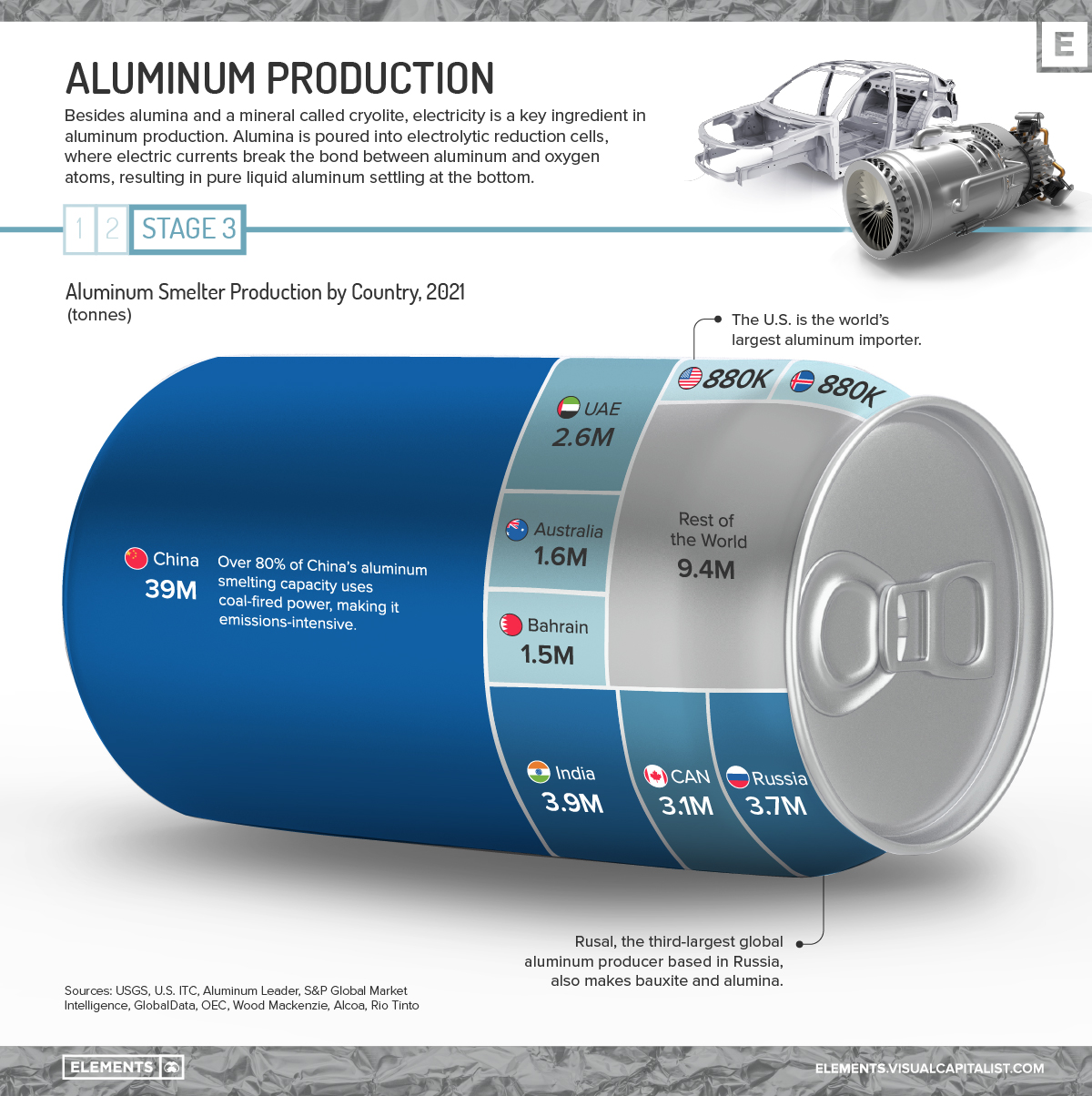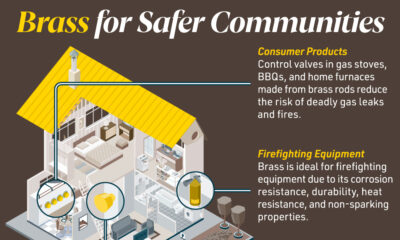Misc
How Is Aluminum Made?
How to Use: Click the arrows on the right to see the next stage of aluminum production.
How is Aluminum Made?
Aluminum is one of our most widely-used metals, found in everything from beer cans to airplane parts.
However, the lightweight metal doesn’t occur naturally, and producing it is a complex process.
The above infographics use data from the USGS, Aluminium Leader, and other sources to break down the three stages of aluminum production.
The Three Stages of Aluminum Production
Each year, the world produces around 390 million tonnes of bauxite rock, and 85% of it is used to make aluminum.
Bauxites are rocks composed of aluminum oxides along with other minerals and are the world’s primary source of aluminum. After mining, bauxite is refined into alumina, which is then converted into aluminum.
Therefore, aluminum typically goes from ore to metal in three stages.
Stage 1: Mining Bauxite
Bauxite is typically extracted from the ground in open-pit mines, with just three countries—Australia, China, and Guinea—accounting for 72% of global mine production.
| Country | 2021 Mine Production of Bauxite (tonnes) | % of Total |
|---|---|---|
| Australia 🇦🇺 | 110,000,000 | 28.2% |
| China 🇨🇳 | 86,000,000 | 22.1% |
| Guinea 🇬🇳 | 85,000,000 | 21.8% |
| Brazil 🇧🇷 | 32,000,000 | 8.2% |
| India 🇮🇳 | 22,000,000 | 5.6% |
| Indonesia 🇮🇩 | 18,000,000 | 4.6% |
| Russia 🇷🇺 | 6,200,000 | 1.6% |
| Jamaica 🇯🇲 | 5,800,000 | 1.5% |
| Kazakhstan 🇰🇿 | 5,200,000 | 1.3% |
| Saudi Arabia 🇸🇦 | 4,300,000 | 1.1% |
| Rest of the World 🌍 | 15,500,000 | 4.0% |
| Total | 390,000,000 | 100.0% |
Australia is by far the largest bauxite producer, and it’s also home to the Weipa Mine, the biggest bauxite mining operation globally.
Guinea, the third-largest producer, is endowed with more than seven billion tonnes of bauxite reserves, more than any other country. Additionally, Guinea is the top exporter of bauxite globally, with 76% of its bauxite exports going to China.
After bauxite is out of the ground, it is sent to refineries across the globe to make alumina, marking the second stage of the production process.
Stage 2: Alumina Production
In the 1890s, Austrian chemist Carl Josef Bayer invented a revolutionary process for extracting alumina from bauxite. Today—over 100 years later—some 90% of alumina refineries still use the Bayer process to refine bauxite.
Here are the four key steps in the Bayer process:
- Digestion:
Bauxite is mixed with sodium hydroxide and heated under pressure. At this stage, the sodium hydroxide selectively dissolves aluminum oxide from the bauxite, leaving behind other minerals as impurities. - Filtration:
Impurities are separated and filtered from the solution, forming a residue known as red mud. After discarding the mud, aluminum oxide is converted into sodium aluminate. - Precipitation:
The sodium aluminate solution is cooled and precipitated into a solid, crystallized form of aluminum hydroxide. - Calcination:
The aluminum hydroxide crystals are washed and heated in calciners to form pure aluminum oxide—a sandy white material known as alumina.
The impurities or red mud left behind in the alumina production process is a major environmental concern. In fact, for every tonne of alumina, refineries produce 1.2 tonnes of red mud, and there are over three billion tonnes of it stored in the world today.
China, the second-largest producer and largest importer of bauxite, supplies more than half of the world’s alumina.
| Country | 2021 alumina production (tonnes) | % of total |
|---|---|---|
| China 🇨🇳 | 74,000,000 | 53% |
| Australia 🇦🇺 | 21,000,000 | 15% |
| Brazil 🇧🇷 | 11,000,000 | 8% |
| India 🇮🇳 | 6,800,000 | 5% |
| Russia 🇷🇺 | 3,100,000 | 2% |
| Germany 🇩🇪 | 1,900,000 | 1% |
| Ireland 🇮🇪 | 1,900,000 | 1% |
| Saudi Arabia 🇸🇦 | 1,800,000 | 1% |
| Ukraine 🇺🇦 | 1,700,000 | 1% |
| Spain 🇪🇸 | 1,600,000 | 1% |
| Rest of the World 🌍 | 15,100,000 | 11% |
| Total | 139,900,000 | 100% |
Several major producers of bauxite, including Australia, Brazil, and India, are among the largest alumina producers, although none come close to China.
Alumina has applications in multiple industries, including plastics, cosmetics, and chemical production. But of course, the majority of it is shipped to smelters to make aluminum.
Stage 3: Aluminum Production
Alumina is converted into aluminum through electrolytic reduction. Besides alumina itself, another mineral called cryolite is key to the process, along with loads of electricity. Here’s a simplified overview of how aluminum smelting works:
- In aluminum smelter facilities, hundreds of electrolytic reduction cells are filled up with molten cryolite.
- Alumina (composed of two aluminum atoms and three oxygen atoms) is then dumped into these cells, and a strong electric current breaks the chemical bond between aluminum and oxygen atoms.
- The electrolysis results in pure liquid aluminum settling at the bottom of the cell, which is then purified and cast into its various shapes and sizes.
China dominates global aluminum production and is also the largest consumer. Its neighbor India is the second-largest producer, making only a tenth of China’s output.
| Country | 2021 Aluminum Smelter Production (tonnes) | % of total |
|---|---|---|
| China 🇨🇳 | 39,000,000 | 59% |
| India 🇮🇳 | 3,900,000 | 6% |
| Russia 🇷🇺 | 3,700,000 | 6% |
| Canada 🇨🇦 | 3,100,000 | 5% |
| United Arab Emirates 🇦🇪 | 2,600,000 | 4% |
| Australia 🇦🇺 | 1,600,000 | 2% |
| Bahrain 🇧🇭 | 1,500,000 | 2% |
| Iceland 🇮🇸 | 880,000 | 1% |
| U.S. 🇺🇸 | 880,000 | 1% |
| Rest of the World 🌍 | 9,400,000 | 14% |
| Total | 66,560,000 | 100% |
As is the case for alumina production, some of the countries that produce bauxite and alumina also produce aluminum, such as India, Australia, and Russia.
Roughly a quarter of annually produced aluminum is used by the construction industry. Another 23% goes into vehicle frames, wires, wheels, and other parts of the transportation industry. Aluminum foil, cans, and packaging also make up another major end-use with a 17% consumption share.
Aluminum’s widespread applications have made it one of the most valuable metal markets. In 2021, the global aluminum market was valued at around $245.7 billion, and as consumption grows, it’s projected to nearly double in size to $498.5 billion by 2030.
Misc
Brass Rods: The Secure Choice
This graphic shows why brass rods are the secure choice for precision-machined and forged parts.

Brass Rods: The Secure Choice
The unique combination of machinability and recyclability makes brass rods the secure choice for manufacturers seeking future-proof raw material solutions.
This infographic, from the Copper Development Association, shows three ways brass rods give manufacturers greater control and a license to grow in the competitive market for precision-machined and forged products.
Future-Proof Investments in New Machine Tools
A material’s machinability directly impacts machine throughput, which typically has the largest impact on machine shop profitability.
The high-speed machining capabilities of brass rods maximize machine tool performance, allowing manufacturers to run the material faster and longer without sacrificing tool life, chip formation, or surface quality.
The high machining efficiency of brass leads to reduced per-part costs, quicker return on investment (ROI) for new machine tools, and expanded production capacity for new projects.
Supply Security Through Closed Loop Recycling
Brass, like its parent element copper, can be infinitely recycled.
In 2022, brass- and wire-rod mills accounted for the majority of the 830,000 tonnes of copper recycled from scrap in the U.S.
Given that scrap ratios for machined parts typically range from 60-70% by weight, producing mills benefit from a secure and steady supply of clean scrap returned directly from customers, which is recycled to create new brass rods.
The high residual value of brass scrap creates a strong recycling incentive. Scrap buy back programs give manufacturers greater control over raw material net costs as scrap value is often factored into supplier purchase agreements.
Next Generation Alloys for a Lead-Free Future
Increasingly stringent global regulations continue to pressure manufacturers to minimize the use of materials containing trace amounts of lead and other harmful impurities.
The latest generation of brass-rod alloys is engineered to meet the most demanding criteria for lead leaching in drinking water and other sensitive applications.
Seven brass-rod alloys passed rigorous testing to become the only ‘Acceptable Materials’ against lower lead leaching criteria recently adopted in the national U.S. drinking water quality standard, NSF 61.
Learn more about the advantages of brass rods solutions.
Misc
Brass Rods: The Safe Choice
From airbags to firefighting equipment, components made from brass rods play a vital role in creating a safer environment.
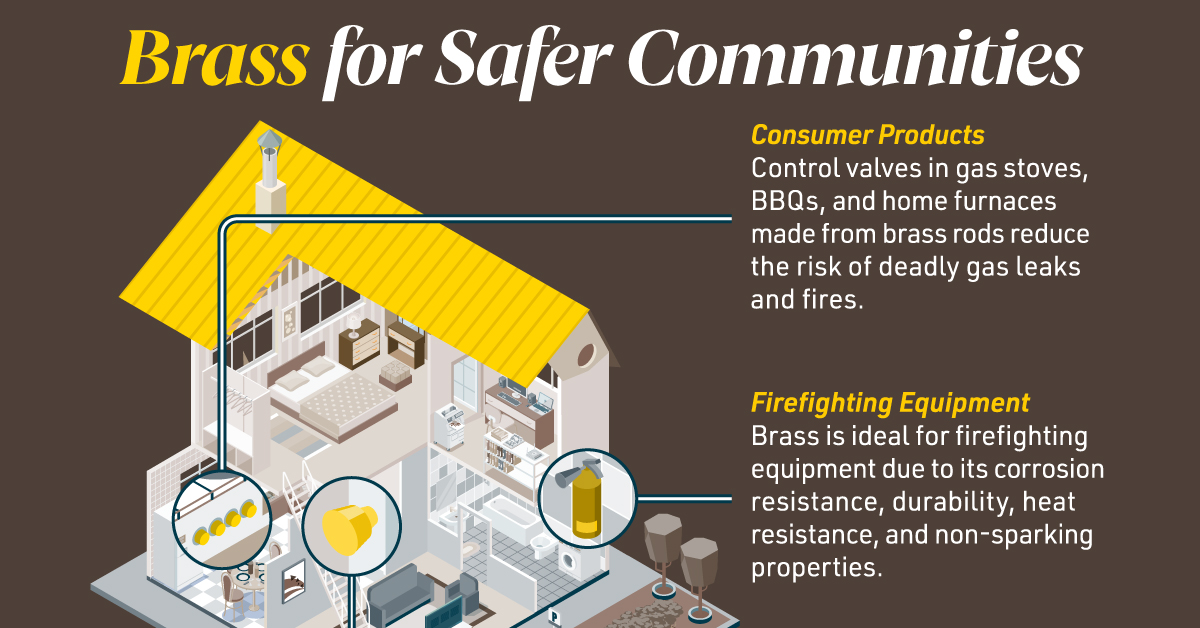
Brass Rods: The Safe Choice
From airbags to firefighting equipment, components made from brass rods play a vital role in creating a safer environment.
This infographic from the Copper Development Association illustrates three use cases for brass. This is the first of three infographics in our Choose Brass series.
Why Brass?
Brass is one of the most reliable metals for industrial and other applications. It contains little to no iron, protecting it from oxidation, which can cause other materials to fail over time.
Additionally, the malleability of brass ensures tight and leak-free metal-to-metal seals for threaded joints, minimizing the risk of costly and dangerous system failures. Brass’s durability ensures critical system components function properly for years.
Brass for Safe Water Systems
Exposure to lead in water can cause various health problems, including neurological damage, developmental delays, and cardiovascular diseases.
As a result, the U.S. sets minimum health-effect requirements for chemical contaminants and impurities indirectly transferred to drinking water from products, components, and materials used in water systems.
Currently, only brass rod alloys are designated as “acceptable materials” according to national standards.
Brass is also essential for ensuring workplace safety, particularly in high-risk manufacturing environments.
Using Brass for Safe Manufacturing and Industrial Environments
Brass is used extensively in industrial applications such as machinery components, valves, fittings, architectural elements, bearings, and gears.
The machinability of brass rods also means longer tool life and higher productivity for manufacturers of precision parts.
The microstructure of brass helps break up metal chips generated during machining operations, preventing long and stringy chips that can crash machines and seriously injure operators.
Additionally, brass’s non-sparking properties make it ideal for tooling, fittings, and components in high-risk industries such as oil & gas, chemicals, pharmaceuticals, paint manufacturing, power plants, and explosives.
Brass for Safer Communities
Many pieces of equipment in our daily lives also rely on brass rod parts to function. Control valves in gas stoves, BBQs, and home furnaces made from brass rods reduce the risk of deadly gas leaks and fires.
Moreover, brass is ideal for firefighting equipment due to its corrosion resistance, durability, heat resistance, and non-sparking properties.
Fittings made from brass rods ensure that the brakes and airbags in our vehicles work when needed.
Brass and other copper-based alloys are also naturally antimicrobial, helping prevent diseases when used in high-touch surfaces such as door handles.
These are only some of the ways that brass rods help build a safer world for everyone.
Explore the Advantages of Brass Rod Solutions.
-

 Electrification3 years ago
Electrification3 years agoRanked: The Top 10 EV Battery Manufacturers
-

 Electrification2 years ago
Electrification2 years agoThe Key Minerals in an EV Battery
-

 Real Assets3 years ago
Real Assets3 years agoThe World’s Top 10 Gold Mining Companies
-

 Misc3 years ago
Misc3 years agoAll the Metals We Mined in One Visualization
-

 Electrification3 years ago
Electrification3 years agoThe Biggest Mining Companies in the World in 2021
-

 Energy Shift2 years ago
Energy Shift2 years agoWhat Are the Five Major Types of Renewable Energy?
-

 Electrification2 years ago
Electrification2 years agoMapped: Solar Power by Country in 2021
-

 Electrification2 years ago
Electrification2 years agoThe World’s Largest Nickel Mining Companies






